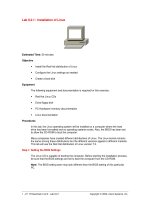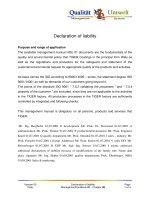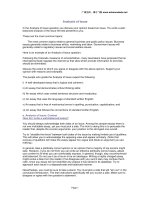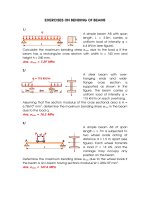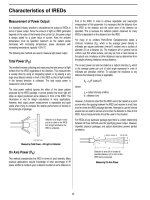Tài liệu PEOPLE OF AFRICA ppt
Bạn đang xem bản rút gọn của tài liệu. Xem và tải ngay bản đầy đủ của tài liệu tại đây (215.08 KB, 81 trang )
PEOPLE OF AFRICA
Etext Production Notes
This public domain Etext edition of Edith A. How's People of Africa
was prepared by:
John Walker
If you discover any errors in this Etext, please report them to me by
E-mail. If you're reporting a discrepancy between the Etext and a
modern edition, please include a complete citation of your source.
Upon close examination, most editions contain minor errors and
discrepancies which I've tried to correct in this Etext. These Etexts
are part of the intellectual heritage we share as humans please help
to make them _perfectly embody_ the authors' legacies to the thousands
of generations and billions of readers whose lives they will enrich.
Beautifully Typeset Etexts
Free Plain Vanilla Etexts don't have to be austere and typographically
uninviting. Most literature (as opposed to scientific publications,
for example), is typographically simple and can be rendered
beautifully into type without encoding it into proprietary word
processor file formats or impenetrable markup languages.
This Etext is encoded in a form which permits it to be both read
directly (Plain Vanilla) and typeset in a form virtually
indistinguishable from printed editions of the work.
To create "typographically friendly" Etexts, I adhere to the following
rules:
1. Characters follow the 8-bit ISO 8859/1 Latin-1 character set.
ASCII is a proper subset of this character set, so any "Plain
ASCII" file meets ths criterion by definition. The extension
to ISO 8859/1 is required so that Etexts which include the
accented characters used by Western European languages may
continue to be "readable by both humans and computers".
2. No white space characters other than blanks and line
separators are used (in particular, tabs are expanded to
spaces).
3. The text bracket sequence:
<><><><><><><><><><><><><><><><><><><><><><><><><><><><><><><
><><><>
appears both before and after the actual body of the Etext.
This allows including an arbitrary prologue and epilogue to
the body of the document.
4. Normal body text begins in column 1 and is set ragged right
with a line length of 70 characters. The choice of 70
characters is arbitrary and was made to avoid overly long and
therefore less readable lines in the Plain Vanilla text.
5. Paragraphs are separated by blank lines.
6. Centring, right, and left justification is indicated by
actually so-justifying the text within the 70 character line.
Left justified lines should start in column 2 to avoid
confusion with paragraph body text.
7. Block quotations are indented to start in column 5 and set
ragged right with a line length of 60 characters.
8. Preformatted tables begin with a line which starts in column 3
and contains at least one sequence of three or more spaces
between nonblanks. The table is formatted verbatim until the
next blank line.
9. Text set in italics is bracketed by underscore characters,
"_". These must match.
10. Footnotes are included in-line, bracketed by "[]". The
footnote appears at the point in the copy where the footnote
mark appears in the source text. Footnotes may not be nested
and may consist of only a single paragraph.
11. The title is defined as the sequence of lines which appear
between the first text bracket "<><><> " and a centred line
consisting exclusively of more than two equal signs "====".
12. The author's name is the text which follows the line of equal
signs marking the end of the title and precedes the first
chapter mark. This may be multiple lines.
13. Chapters are delimited by a three line sequence of centred
lines:
<Chapter number>
<Chapter name>
The line of minus signs must be centred and contain three or
more minus signs and no other characters apart from white
space. Chapter "numbers" need not be numeric they can be any
text.
14. Dashes in the text are indicated in the normal typewritten
text convention of " ". No hyphenation of words at the end
of lines is done.
15. Ellipses are indicated by " "; sentence-ending ellipses by
" ".
16. Greek letters and mathematical symbols are enclosed in the
brackets "\(" and "\)" and are expressed as their character or
symbol names in the LaTeX typesetting language. For example,
write the Greek word for "word" as:
\( \lambda \acute{o} \gamma o \varsigma \)
and the formula for the roots of a quadratic equation as:
\( x_{1,2} = \frac{-b \pm \sqrt{b^2 - 4ac}}{2a} \)
I acknowledge that this provision is controversial. It is as
distasteful to me as I suspect it is to you. In its defence,
let me treat the Greek letter and math formula cases
separately. Using LaTeX encoding for Greek letters is purely
a stopgap until Unicode comes into common use on enough
computers so that we can use it for Etexts which contain
characters not in the ASCII or ISO 8859/1 sets (which are the
7- and 8-bit subsets of Unicode, respectively). If an author
uses a Greek word in the text, we have two ways to proceed in
attempting to meet the condition:
The etext, when displayed, is clearly readable, and
does *not* contain characters other than those
intended by the author of the work, although
The first approach is to transliterate into Roman characters
according to a standard table such as that given in _The
Chicago Manual of Style_. This preserves readability and
doesn't require funny encoding, but in a sense violates the
author's "original intent" the author could have
transliterated the word in the first place but chose not to.
By transliterating we're reversing the author's decision. The
second approach, encoding in LaTeX or some other markup
language, preserves the distinction that the author wrote the
word in Greek and maintains readability since letters are
called out by their English language names, for the most part.
Of course LaTeX helps us only for Greek (and a few characters
from other languages). If you're faced with Cyrillic, Arabic,
Chinese, Japanese, or other languages written in non-Roman
letters, the only option (absent Unicode) is to transliterate.
I suggest that encoding mathematical formulas as LaTeX
achieves the goal of "readable by humans" on the strength of
LaTeX encoding being widely used in the physics and
mathematics communities when writing formulas in E-mail and
other ASCII media. Just as one is free to to transliterate
Greek in an Etext, one can use ASCII artwork formulas like:
+ / 2
-b - \/ b - 4ac
x =
1,2 2a
This is probably a better choice for occasional formulas
simple enough to write out this way. But to produce Etexts of
historic scientific publications such as Einstein's "Zur
Elektrodynamik bewegter K”rper" (the special relativity paper
published in _Annalen der Physik_ in 1905), trying to render
dozens of complicated equations in ASCII is not only extremely
tedious but in all likelihood counter-productive; ambiguities
in trying to express complex equations would make it difficult
for a reader to determine precisely what Einstein wrote unless
conventions just as complicated (and harder to learn) as those
of LaTeX were adopted for ASCII expression of mathematics.
Finally, the choice of LaTeX encoding is made not only based
on its existing widespread use but because the underlying
software that defines it (TeX and LaTeX) are entirely in the
public domain, available in source code form, implemented on
most commonly-available computers, and frozen by their authors
so that, unlike many commercial products, the syntax is
unlikely to change in the future and obsolete current texts.
17. Other punctuation in the text consists only of the characters:
. , : ; ? ! ` ' ( ) { } " + = - / * @ # $ % & ~ ^ | < >
In other words, the characters:
_ [ ] \
are never used except in the special senses defined above.
18. Quote marks may be rendered explicitly as open and close quote
marks with the sequences `single quotes' or ``double quotes''.
As long as quotes are balanced within a paragraph, the ASCII
quote character `"' may be used. Alternating occurrences of
this character will be typeset as open and close quote
characters. The open/close quote state is reset at the start
of each paragraph, limiting the scope of errors to a single
paragraph and permitting ``continuation quotes'' when multiple
paragraphs are quoted.
A program to translate Etexts prepared in this format into:
LaTeX (and thence to PostScript or PDF, if you wish)
HTML for posting on the Web
or Palm Reader format for handhelds
may be downloaded from:
The program is in the public domain and includes complete source code.
<><><><><><><><><><><><><><><><><><><><><><><><><><><><><><><
><><><>
PEOPLE OF AFRICA
=====================================
by Edith A. How, B.A.
Universities' Mission to Central Africa
With Six Coloured Illustrations
LONDON
Society for Promoting Christian Knowledge
New York: The Macmillan Co.
1921
PREFACE
It is hoped that this book and its companion volume dealing with
non-African peoples will be the beginning of a series of simple,
readable accounts for Africans of some of the various objects of
general interest in the world of to-day. There are many such works
published for the use of English and American children. But the
native African has a totally different experience of life, and much
that is taken for granted by a child of a Northern civilized land
needs explanation to one used to tropical uncivilized surroundings.
Again, the African knows the essential operations of everyday life in
their simplest form, whereas the European knows them disguised by an
elaborate industrial system. All this makes books written for English
children almost unintelligible to a member of a primitive race.
These two volumes are far from perfect, but it has been difficult to
know always how to select wisely from the mass of material at hand.
They will have served, however, a useful purpose if they form a basis
for adaptations into the various African vernaculars, and afford an
inspiration for other works of a similar nature. Thanks are due to
Miss K. Nixon Smith, of the Universities Mission to Central Africa,
for her kindness in criticizing the MSS. from her long experience of
the African outlook.
EDITH A. HOW
_June_, 1920.
I
INTRODUCTION
In this book we are going to read about some of the other people who
live in our own great country Africa. Africa is very, very large, so
big that no one would be able to go to all the places in it. But
different people have been to different parts, and have told what they
saw where they went. Wherever our home in Africa may be, if we walked
towards the sunrise that is, towards the east day after day, at last
we should reach the great salt sea. Again, if we walked towards the
sunset in the west, we should at last get to the sea. To the north,
again, is the sea, and to the south, the sea. Whichever way we
walked, at last, after many months, we should be stopped by the sea.
But on our journey we should have met many different kinds of people,
and have seen many different customs. In some places there would be
rivers, in some mountains, in some deserts, with no trees or grass to
be seen. In these, people must make their homes in many ways, and
have many kinds of food and clothes. Because we live in Africa, we
want to know about Africa and the people in it. They are men and
women and children like ourselves, though the colour of their skins
may be lighter or darker than ours, and their languages quite
different. But they, too, build houses and eat food and wear some
kind of dress, and it is interesting to know about their customs. So
in this book we shall read about some of them and of how they live;
and, to help us to understand, we shall find with each part a picture
of the people we are reading about. All the time we must remember
that we could get to see them for ourselves if we were strong enough
to walk so far, because they are all our own brothers and sisters in
Africa.
Long ago most African peoples were shut off from the other people of
the world by the sea and the great sandy desert. Only the people of
Egypt could meet and learn from the people of Europe and Asia. So
while the Egyptians grew wise and clever, all the other Africans,
south of the desert, knew nothing except what they had learnt by
themselves. Then Arabs began to cross the desert to get gold and
slaves from the dark-skinned Africans. These Arabs taught them a
little. But, later still, Europeans began to come in great ships over
the sea. These came at first like the Arabs to trade, and afterwards
began to plant great fields of cotton and tobacco, which will not grow
in their own lands. But they found the dark-skinned Africans were
still ignorant, and afraid of people of other races. They were always
fighting among themselves, and no one could settle among them until
there was peace and safety. At last the European nations made
agreements with the chiefs, so that now in nearly every part of Africa
there is a European governor to prevent wars and fighting. Thus in
North Africa the governors are sent by France, in the Congo lands by
Belgium, in East Africa by England, in some other parts by Portugal.
These are different European nations who send men to keep peace, and
to make it possible to carry on trade. Of course, the coming of the
Europeans has made great changes in the lives of the Africans. In the
old times all the men were busy fighting, and often whole villages of
people were killed or made slaves. Now there is no fighting, but
there is more need to work than before. There are more people, and
less land for each family. Europeans want workmen to help on their
great fields. The Africans want many things now, which they did not
know about before, and they must have money to buy them. So work for
money has taken the place of fighting. Again, in some ways the
Europeans, enforcing peace and making many quick ways of travel, such
as good roads and bridges, have helped to weaken the power of the
chiefs. Nobody likes changes to come, and the old people are always
sorry when their children begin new customs; but on the whole it is
good for Africans that other nations came to their country, because
they have brought peace in the place of war, and safety and freedom
instead of the old fear of death or slavery.
II
EGYPT
1. The Country and its River
Egypt is a country in the north of Africa. It has sea to the north
and sea to the east. On the north it is called the Mediterranean Sea,
and on the east the Red Sea. On the west is the great sandy desert
called the Sahara, and to the south are great forests and mountains.
Egypt itself is the land of the great River Nile. There is very
seldom any rain there, and everyone has to get water from the great
river. So all the people live near the Nile or the canals which lead
out of it. A "canal" is a waterway, the channel of which has been dug
by men. The big towns are where the river flows out into the sea, or
where a canal meets the main stream, because the people bring their
merchandise to market in boats. All over the land are little
villages, where many people live and work in the fields to grow food.
Year by year when there is heavy rain in the mountains far away south,
the River Nile rises and floods the fields. Then the people plant
their seed quickly and get a good harvest. It is not difficult to
understand why the Egyptians love their great river, which gives them
water for their fields and carries them in their boats from place to
place.
2. Its Past History
Egypt is the only part of Africa that could be reached easily by
people in Europe and Asia, because in Egypt is the only place where
men could walk from Asia and Europe into Africa. Even if they did not
want to walk, the sea was not too wide to cross in small boats. In
the Bible we read how Abraham, who lived in Asia, walked to Egypt, and
later how Moses led the Children of Israel back to Asia. Since that
time Europeans have cut a waterway for ships through this narrow neck
of land, which is called the Suez Canal. So now people can no longer
walk from Asia to Africa, but in the old days the Egyptians grew wiser
than others in Africa, because they were more able to meet men from
other lands in Asia and Europe, and to learn something from them all.
So hundreds and hundreds of years ago there were people living in this
country of the Nile who were wise and great. They built large cities
and temples and houses. They knew how to write, and covered the walls
of their houses with writing. Their letters were not like ours, but
were pictures of the things they were writing about. They also built
huge stone tombs for their kings to be buried in, and these were
called "pyramids." The kings of Egypt were called "Pharaohs." When the
old Egyptians wrote books, instead of paper they used the dried leaves
of a reed called "papyrus," which grows in the Nile. Several leaves
were fastened together to make a book. These old writings on reeds
and on the walls have been found after lying buried in the sand, which
has covered so much of old Egypt. The hot sand has kept them dry, and
prevented them being destroyed during hundreds of years. By reading
these writings we are able to find out how these people lived so long
ago. They had also a wonderful way of taking the waters of the Nile
in ditches over the whole land. There is hardly any rain in Egypt,
and this Nile water prevented the country becoming so sandy and dry.
In those days Egypt was well-known for its wonderful harvests and
stores of food.
But though these people were wise in many ways, yet they were proud
and cruel to their enemies. In the Bible we read how they treated the
Children of Israel in the time of Moses. Perhaps this was because
they did not know God our Father, but worshipped many gods, whose
pictures and images were like animals. Many of the great temples they
built for these gods are still standing, and when we see pictures of
them, we wonder at the skill of these people who lived so long ago.
Egypt was one of the first great countries to become Christian, and
many of the old heathen temples were turned into churches. But at
last the Arabs, who were Mohammedans, conquered Egypt, and forced most
of the people to become Mohammedans too. But some remained faithful
in spite of all, and these to-day are called "Copts," from the old
name for Egypt. For hundreds of years these Copts have lived in a
country ruled by Moslem Arabs, or Turks, who hated their religion, but
they have been true to Christ through all.
There are people of all lands living in the towns of Egypt in these
days, for there is a great deal of business to be done in them. But
the people who work in the fields are the children of the old
Egyptians, though they have forgotten their old wisdom and are now
very ignorant.
3. The People of Egypt
The Egyptians are a race different both from the dark-skinned people
of Africa and from Europeans. They have olive skins, very dark,
almond-shaped eyes, and dark, straight hair. Most of the men shave
their heads, and wear a turban or tarboosh as a covering. The women
fasten a veil below their eyes, which falls over the lower part of
their face. Both the men and the women wear several loose garments,
which cover the whole body from the neck to the feet. All except the
very poor wear shoes.
In the towns there are a great many people, some very rich and others
very poor. Often a city looks very beautiful, because the houses are
built of white or light-coloured stone or brick. But they are close
together, and the streets are very narrow and dirty, and so the poor
people are often ill. The houses are built in "storeys," one room on
the top of another, with steps leading to the upper rooms. Often
there is a courtyard in the middle of the house, so that all the rooms
can have windows and light. One part of the house is separated from
the rest for the women to use. This is called the "hareem," and no
man, except the master of the house, is allowed to go into it. All
rich Mohammedans have a separate part of their house for the women. A
poor woman in all countries has plenty of work to do, but a rich lady
in Egypt has many servants, or slaves, to do the work, and, as she is
kept shut up in the "hareem" from the time she is ten or eleven years
old, she can learn very little, except how to do beautiful needlework.
She cannot help her husband and her sons to be wise and good, because
she does not know enough about life and work outside the "hareem." So
the Egyptian ladies have little to do and little to think about all
the day while their husbands are away, and they are often very dull.
But the town-people love their children very much, and Egyptian
children are taught always to love, honour, and obey their father and
mother. An Egyptian man may have four wives, but generally he has
only one.
Until a few years ago, all Egyptians who had enough money used to buy
slaves to do their work. Slaves could be bought or sold, or married
or given away, as if they were things instead of people. Masters
could illtreat or even kill their slaves and not be punished, because
it was only as if they had broken their water-jar in a temper, and
that was no one else's business. Often slaves were happy if they had
good masters, but it is a bad custom to take away a person's freedom
and treat him as if he had no soul. During the last few years many
Europeans have been helping the Egyptians to improve their country,
and one of the changes has been to do away gradually with slavery. No
one is now allowed to buy a slave, and anyone born in slavery can
become free if he wishes to do so. Instead of slaves, people now have
servants who receive wages for their work. These are free to leave
their master if he does not treat them well. Although slavery is
dying out of Egypt, there are other parts of North Africa where the
old bad customs still exist, though the great European nations try to
prevent the public markets for slaves being held. People are happiest
in countries where there are no slaves and everyone is free to do the
work for which he is best fitted.
In Egyptian households where there is more than one wife there is
often quarrelling. The wives of one man all live in one "hareem," and
cannot help being jealous if they see their husband likes one better
than another. Then there is quarrelling and ill-will among them. As
the children grow up there is a further cause for jealousy, because
the mothers of boys are more important than those who have only
girl-children. Children cannot respect their mothers if they often
see them quarrelling and jealous. Again, there is always a
possibility that a husband may divorce his wife. He is not likely to
do so if she has a boy-baby, but until she has, her position as a wife
is not very secure. These bad marriage customs lead to much
unhappiness, and prevent the women of Egypt from doing so much good as
the women of some other lands are able to do. We must not, of course,
think that all Egyptian homes are unhappy; probably many poor women
are quite glad when their husband brings another wife to help with the
work. But where servants do the work, there are only the pleasures of
the home to be shared, and then jealousy will be likely to come.
4. The Big Towns
If we went for a walk in the narrow streets of an Egyptian city or big
town, we should see on either side open shops, each with its owner
ready to sell his goods. Many of the people of the towns have shops
or trades. They sell jewellery, furniture, cloth, and everything that
is wanted in the house for cooking. In the streets there are some men
carrying drinking-water for sale, because it is hot walking about and
people get thirsty. Others will be selling sweet-stuff made of sugar,
which everyone likes. Others wait about ready to write letters for
people who cannot write for themselves, and there are always many
beggars. Great steamers from other countries England, France, India,
Japan bring merchandise to Alexandria and Port Said, the seaports of
Egypt, and so people from these countries have shops and offices in
those towns. Then the goods are taken by boats or trains to the
capital, Cairo, where the Sultan lives, and to other large towns. In
all these towns there are hundreds of people, so that a man can only
know those who live near him or work with him. Most of them are
unknown to one another and are like strangers, although they all live
in one town and can all speak Arabic.
5. Life in the Villages
The country-people of Egypt are very poor, and have to work very hard
all the year round in their fields. Their houses are built of bricks
dried in the sun, plastered together with mud, and the roof is made of
plaited palm leaf. Inside there is only one room, which has a big
oven made of mud with a flat top on which the father and mother sleep.
The work in the fields is very hard, as the ground has to be made
fertile by digging canals and ditches all over it to bring the water
from the Nile, because, you remember, there is no rain in Egypt. When
the Nile begins to fall, the water has to be raised in baskets
fastened to a wheel or pole, and thrown on the ground. In order to
get enough money, the people plant another kind of seed as soon as one
harvest is gathered; first, perhaps, planting wheat, then millet, or
cotton, then maize. So the country-people in Egypt are always working
hard from sunrise to sunset all the year in their fields, and their
little children have to learn to mind sheep, goats, or cattle, and to
help in other ways as soon as they can walk alone.
Other men work on the Nile, carrying people or goods up and down the
river in boats from place to place. This, again, is hard work, but
the boatmen seem very happy and often sing as they pass along. People
in the country villages are ignorant, and very few can read or write.
Sometimes when the harvest has been bad and food is dear and scarce,
the people get deeply into debt. There is a great deal of illness and
disease, but there are very few doctors and nurses to help people to
get well. So the life of an Egyptian peasant is a hard one a great
deal of work and very little time to rest, or play, or learn. But
everyone has something to make him happy, and, unless there is famine
or pestilence, these people have their wives and children and home,
just as people have in England and other countries. The only person
who need be unhappy is the one who has no one to love.
So we have learnt a little about that part of Africa called Egypt the
land of the Nile and about the people who live in it. We must
remember that all the other people who live on the North Coast of
Africa, in Tunis, Algeria, and Morocco, are something like the
Egyptians, also speaking Arabic, and different from the dark-skinned
people who live farther south where it is very hot.
III
THE SAHARA, THE GREAT SANDY DESERT
1. What the Desert is Like
In the last chapter we were reading about Egypt, and we said that on
the West of Egypt lay the Great Desert. Now a desert is a place where
for some reason no food will grow. In some deserts the soil is too
bad; in some the ground is covered with salt; in others, like the
Sahara, there are no rivers. In some places in the Sahara there is
water coming up through a crack in the rocks. This water is called a


